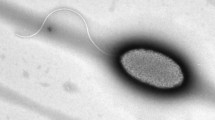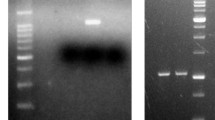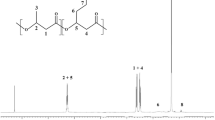Abstract
Pseudomonas acidophila can grow with CO2 as a sole carbon source by the possession of a recombinant plasmid that clones genes that confer chemolithoautotrophic growth ability derived from the H2-oxidizing bacteriumAlcaligenes hydrogenophilus. H2-oxidizing bacteria produce poly(3-hydroxybutyric acid) (PHB) from CO2, but recombinant P.acidophila can produce the more useful biopolymer poly(3-hydroxyalkanoic acid) (PHA). In this study, thepha genes ofP. acidophila were cloned and a sequence analysis was carried out. A gene library was constructed using the cosmid vector pVK102. A recombinant cosmid carrying thepha genes was selected by the complementation of a PHB-negative mutant ofAlcaligenes eutrophus H16. The resulting recombinant cosmid pIK7 contained a 14.8-kb DNA insert. Subcloning was done, and the recombinant plasmid pEH74 was selected by hybridization with theA. eutrophus H16pha genes.Escherichia coli possessing pEH74 produced PHB, indicating that pEH74 contained thepha genes ofP. acidophila. The nucleotide sequences of the PHA-synthesis genesphaA (3-ketothiolase),phaB (acetoacetyl-CoA reductase), andphaC (PHA synthase) in pEH74 were determined. The homologies ofphaA, phaB, andphaC betweenP. acidophila andA. eutrophus H16 were 64.7, 76.1, and 56.6%, respectively.
Similar content being viewed by others
References
Anderson, A. J. and Dawes, E. A. (1990),Microbiol. Rev. 54, 450–472.
Steinbüchel, A. (1991),Biomaterials, Byrom, D., ed., MacMillan, Basingstoke, UK, pp. 123–213.
Holmes, P. A. (1985),Phys. Technol. 16, 32–36.
Repaske, R. and Mayer, R. (1976),Appl. Environ. Microbiol. 32, 592–597.
Umeda, F., Tanaka, N., Kimura, N., Nishie, H., Yagi, K., and Miura, Y. (1991),J. Ferment. Bioeng. 71, 379–383.
Miura, Y. and Umeda, F. (1994),Yakugaku Zasshi 114, 63–72.
Yagi, K., Miyawaki, I., Kayashita, A., Kondo, M., Kitano, Y., Murakami, Y., Maeda, I., Umeda, F., Miura, Y., Kawase, M., and Mizoguchi, T. (1996),Appl. Environ. Microbiol. 62, 1004–1007.
Ishizaki, A. and Tanaka, K. (1991),J. Ferment. Bioeng. 71, 254–257.
Doi, Y., Tamaki, A., Kunioka, M., and Doga, K. (1988),Appl. Microbiol. Biotechnol. 28, 330–334.
Ohi, K., Takada, N., Komemushi, S., Okazaki, M., and Miura, Y. (1979),J. Gen. Appl. Microbiol. 25, 53–58.
Maniatis, T., Fritsch, E. F., and Sambrook, J. (1982),Molecular Cloning: A Laboratory Manual. Cold Spring Harbor Laboratory Press, Cold Spring Harbor, NY.
Sanger, F., Nicklen, S., and Coulson, A. R. (1977),Proc. Natl. Acad. Sci. USA 74, 5463–5467.
Chen, E. J. and Seeburg, P. H. (1985),DNA 4,165–170.
Peoples, O. P. and Sinskey, A. J. (1989),J. Biol. Chem. 264, 15,298–15,303.
Valentin, H. and Steinbüchel, A. (1993),Appl. Microbiol. Biotechnol. 39, 309–317.
Pieper, U. and Steinbüchel, A. (1992),FEMS Microbiol. Lett. 96, 73–80.
Huisman, G. W., Wonink, E., Meima, R., Kazemier, B., Terpstra, P., and Witholt, B. (1991),J. Biol. Chem. 266, 2191–2198.
Timm, A. and Steinbüchel, A. (1992),Eur. J. Biochem. 209, 15–30.
Liebergesell, M. and Steinbüchel, A. (1992),J. Biochem. 209, 135–150.
Liebergesell, M. and Steinbüchel, A. (1993),Appl. Microbiol. Biotechnol. 38, 493–501.
Peoples, O. P. and Sinskey, A. J. (1989),J. Biol. Chem. 264, 15,293–15,297.
Peoples, O. P. and Sinskey, A. J. (1989),Mol. Microbiol. 3, 349–357.
Griebel, R. and Merrick, J. M. (1971),J. Bacteriol. 108, 782–789.
Persson, B., B.-Olivecrona, G., Enerback, S., Olivecrona, T., and Jornvall, H. (1989),Eur. J. Biochem. 179, 39–45.
Ploux, O., Masamune, S., and Walsh, C. T. (1988),Eur. J. Biochem. 174, 177–182.
Steinbüchel, A., Aerts, K., Babel, W., Föllner, C., Liebergesell, M., Madkour, M. H., Mayer, F., Pieper-Furst, U., Pries, A., Valentin, H. E., and Wieczorek, R. (1995),Can. J. Microbiol. 41, 94–105.
Schubert, P., Krüger, N., and Steinbüchel, A. (1991),J. Bacteriol. 173, 168–175.
Hawley, D. K. and McClure, W. R. (1988),Nucleic Acids Res. 11, 2237–2255.
Author information
Authors and Affiliations
Rights and permissions
About this article
Cite this article
Umeda, F., Kitano, Y., Murakami, Y. et al. Cloning and sequence analysis of the poly(3-hydroxyalkanoic acid)-synthesis genes ofPseudomonas acidophila . Appl Biochem Biotechnol 70, 341–352 (1998). https://doi.org/10.1007/BF02920150
Issue Date:
DOI: https://doi.org/10.1007/BF02920150




